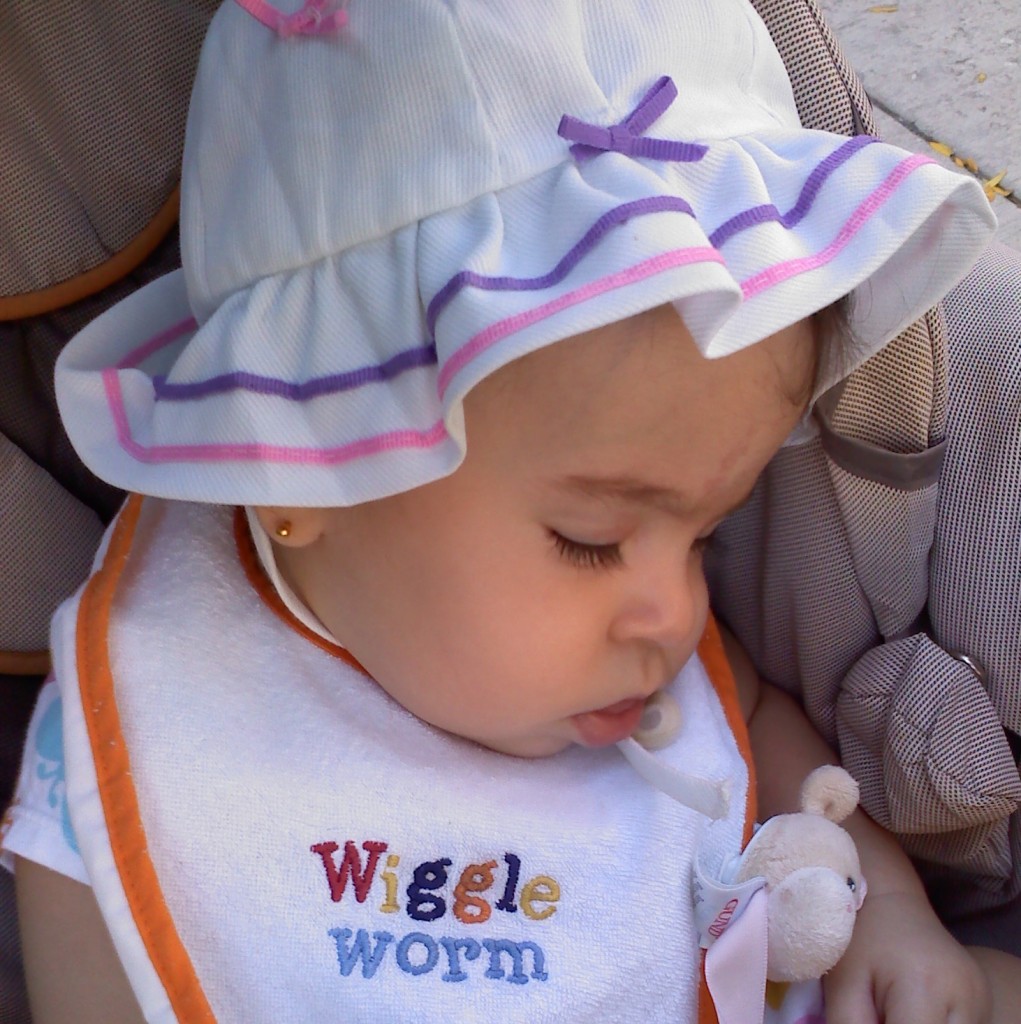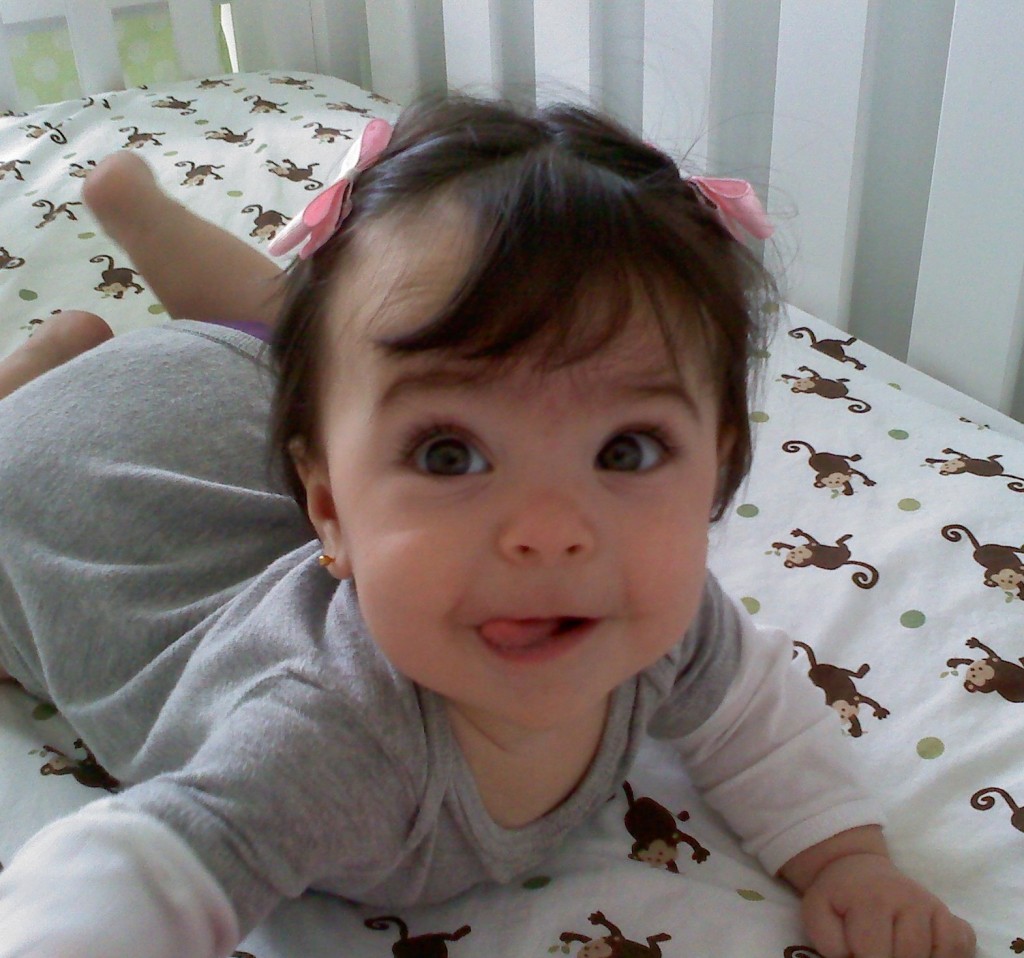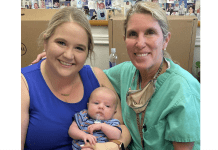 “When may her ears be pierced?” was among one of the first questions I asked our pediatrician at our daughter’s first wellness visit. For me, having her ears pierced as a newborn was just as normal as a southern mother dressing her daughter in smocked dresses and large hair bows. And, there were no medical reason why she could not wear a pair of stud earrings. Even the American Academy of Pediatrics (AAP) indicated there is little risk, as long as done properly.
“When may her ears be pierced?” was among one of the first questions I asked our pediatrician at our daughter’s first wellness visit. For me, having her ears pierced as a newborn was just as normal as a southern mother dressing her daughter in smocked dresses and large hair bows. And, there were no medical reason why she could not wear a pair of stud earrings. Even the American Academy of Pediatrics (AAP) indicated there is little risk, as long as done properly.
Being one of four girls with a Latin background, and having each of our ears pierced only days after our birth, it was only customary that our daughter would follow our tradition. I did not even give it a second thought, much less get approval from my husband, as in our family it is a right of passage. Despite it being a very normal custom in Spain and Latin America, and practiced by Latins in the United States, there is still debate whether girls, much less infants, should have their ears pierced. My mother recalls getting numerous comments both from random strangers at the grocery store line and other mothers at our school. Despite hearing comments and questions from random strangers as well when my little one flashes a pair, I would still have passed on this tradition.
Pediatricians offer this procedure in their office, providing a safe and clean environment. Some offices require certain vaccinations before hand; in our case, we had it done after her four month office visit. Pediatricians who provide the service have a routine and do it with such ease that it takes no longer than a few seconds. Some jewelry stores offer this service as well.
 Suggestions Before the Procedure
Suggestions Before the Procedure
- Pediatrician offices and ear piercing shops may have requirements on minimum age and vaccinations required before the procedure.
- Ask you physician if your child should have a dose of infants’ acetaminophen or ibuprofen beforehand to be comfortable during the procedure, as they do not use anesthesia.
- If the procedure is done outside a physician’s office, confirm if an ear piercing gun is used. Ear piercing guns cannot be sterilized so ensure you are visiting a reputable location.
- Since ear piercing is not considered a medical wellness visit at a physician’s office, your insurance company will probably not cover the cost.
- Confirm studs will be provided during your visit or bring your own pair for approval. Physician offices usually provide sterilized earrings with larger posts, to create an easier opening to clean, and twist ends, to help avoid those tiny hands from removing them.
- Purchase cotton swabs or cotton balls and alcohol or hydrogen peroxide. (I preferred using cotton swabs as they helped reach the opening easier.)
Things to Remember After the Procedure
- Clean the area for at least six weeks, at least twice a day. And, twist earrings in a clockwise motion at least once a day. Also, ensure the area is dry after bathing or cleaning.
- On rare occasions, individuals may have an allergic reaction to the metal used in the earring. Keep your eye on the areas for any changes and contact your physician if redness or irritation occurs.
- Little ones will be tempted to rub or touch the earrings and new opening. Clean the post and ears regularly to avoid infection. Use the materials listed above and follow the instructions provided religiously. Contact your physician if area becomes swollen, if there is increased redness and tenderness or if a fever occurs.
- Once the recommended time has elapsed, switch the earrings to a regular pair. Keeping the larger posts in the opening will create a larger opening.

















We got Mia’s ears pierced after she got her 6mo shots as that was the requirement at our pedi’s office. I think my mom said I got mine pierced at 2 weeks old. I have friends who think it’s selfish to do it before a child can make it their own decision but it’s also very much a normal thing in our family as well. It’s also my dad’s favorite thing to buy… tiny jewelry! 😉
Thanks for sharing, Stephanie! My parents as well love to buy her earrings, along with other jewelry.
I got my 1st daughters ears pierced after her 6 month well check. My second daughters 6month well check is Monday so her will be getting pierced soon thereafter. I had absolutely no problems with my oldest daughters and I am hoping the same is true for the second! Thanks for sharing!
Thanks for sharing, Andrea! I hope your daughter’s 6 month wellness visit and ear piercing go well!
Both girls when they between 3-6
Months 🙂
Thanks for sharing, Stacey!
I got my first daughter’s ears pierced at exactly 12 weeks and for my second I actually got it done Saturday 2 days after 11 weeks old. I wouldn’t have it any other way either I completely agree on the southern charm type of tradition. They did great and have not had one issue.
In my family the tradition has been that girls get their ears pierced the year they make first communion, and our customary gift is tiny silver or gold cross earrings. I personally don’t like the idea of piercing as infants.
At 3 1/2 months… Dad and Uncle took her. Glad we decided to have it done then rather than waiting.
What is the APP Position on Ear Piercing Guns?
It is the position of the Association of Professional Piercers that only sterile disposable equipment is suitable for body piercing, and that only materials which are certified as safe for internal implant should be placed in inside a fresh or unhealed piercing. We consider unsafe any procedure that places vulnerable tissue in contact with either non-sterile equipment or jewelry that is not considered medically safe for long-term internal wear. Such procedures place the health of recipients at an unacceptable risk. For this reason, APP members may not use reusable ear piercing guns for any type of piercing procedure.
While piercing guns may seem to be a quick, easy and convenient way of creating holes, they have major drawbacks in terms of sterility, tissue damage and inappropriate jewelry design. These concerns are addressed below.
Reusable ear piercing guns can put clients in direct contact with the blood and body fluids of previous clients.
Although they can become contaminated with bloodborne pathogens dozens of times in one day, ear piercing guns are often not sanitized in a medically recognized way. Plastic ear piercing guns cannot be autoclave sterilized and may not be sufficiently cleaned between use on multiple clients. Even if the antiseptic wipes used were able to kill all pathogens on contact, simply wiping the external surfaces of the gun with isopropyl alcohol or other antiseptics does not kill pathogens within the working parts of the gun. Blood from one client can aerosolize, becoming airborne in microscopic particles, and contaminate the inside of the gun. The next client’s tissue and jewelry may come into contact with these contaminated surfaces. There is thus a possibility of transmitting bloodborne disease-causing microorganisms through such ear piercing, as many medical studies report.
As is now well known, the Hepatitis virus can live for extended periods of time on inanimate surfaces, and could be harbored within a piercing gun for several weeks or more. Hepatitis and common staph infections, which could be found on such surfaces, constitute a serious public health threat if they are introduced into even one reusable piercing gun. Considering the dozens of clients whose initial piercings may have direct contact with a single gun in one day, this is a cause for serious concern. Babies, young children, and others with immature or compromised immune systems may be at higher risk for contracting such infection.
Additionally, it is not documented how often piercing guns malfunction. Some operators report that the earring adapter that holds the jewelry will often not release the earring, requiring its removal with pliers. These pliers, which contact contaminated jewelry immediately after it has passed through the client’s tissue, may be reused on multiple customers without full sterilization. Few, if any, gun piercing establishments possess the expensive sterilization equipment (steam autoclave or chemclave) necessary for such a procedure.
Piercing guns can cause significant tissue damage.
Though slightly pointy in appearance, most ear piercing studs are quite dull. Piercings must therefore be accomplished by using excessive pressure over a larger surface area in order to force the metal shaft through the skin. The effect on the body is more like a crush injury than a piercing and causes similar tissue damage. Medically, this is referred to as “blunt force trauma.” At the least, it can result in significant pain and swelling for the client, at the most in scarring and potentially increased incidence of auricular chondritis, a severe tissue disfigurement.
Occasionally the intense pressure and speed of the gun’s spring-loaded mechanism is not sufficient to force the blunt jewelry through the flesh. In these cases, the earring stud may become lodged part way through the client’s ear. The gun operator, who may not be trained to deal with this possibility, has two options. S/he can remove the jewelry and repierce the ear, risking contamination of the gun and surrounding environment by blood flow from the original wound. Alternately, the operator can attempt to manually force the stud through the client’s flesh, causing excessive trauma to the client and risking a needlestick-type injury for the operator. How often such gun malfunction occurs has not been documented by manufacturers, but some gun operators report that it is frequent.
When used on structural tissue such as cartilage, more serious complications such as auricular chondritis, shattered cartilage and excessive scarring are common. Gun piercings can result in the separation of subcutaneous fascia from cartilage tissue, creating spaces in which fluids collect. This can lead to both temporary swelling and permanent lumps of tissue at or near the piercing site. These range from mildly annoying to grossly disfiguring, and some require surgery to correct. Incidence can be minimized by having the piercing performed with a sharp surgical needle, which slides smoothly through the tissue and causes less tissue separation. A trained piercer will also use a post-piercing pressure technique that minimizes hypertrophic scar formation.
Cartilage has less blood flow than lobe tissue and a correspondingly longer healing time. Therefore infections in this area are much more common and can be much more destructive. The use of non-sterile piercing equipment and insufficient aftercare has been associated with increased incidence of auricular chondritis, a severe and disfiguring infection in cartilage tissue. This can result in deformity and collapse of structural ear tissue, requiring antibiotic therapy and extensive reconstructive surgery to correct. Again, medical literature has documented many such cases and is available on request.
The length and design of gun studs is inappropriate for healing piercings.
Ear piercing studs are too short for some earlobes and most cartilage. Initially, the pressure of the gun’s mechanism is sufficient to force the pieces to lock over the tissue. However, once they are locked on, the compressed tissue cannot return to its normal state, is constricted and further irritated. At the least, the diminished air and blood circulation in the compressed tissue can lead to prolonged healing, minor complications and scarring. More disturbingly, the pressure of such tight jewelry can result in additional swelling and impaction. Both piercers and medical personnel have seen stud gun jewelry completely embedded in ear lobes and cartilage (as well as navels, nostrils and lips), even when pierced “properly” with a gun. This may require the jewelry to be cut out surgically, particularly in cases where one or both sides of the gun stud have disappeared completely beneath the surface of the skin. Such consequences are minimal when jewelry is custom fit to the client, allows sufficient room for swelling, and is installed with a needle piercing technique which creates less trauma and swelling.
Jewelry that fits too closely also increases the risk of infection because it does not allow for thorough cleaning. During normal healing, body fluids containing cellular discharge and other products of the healing process are excreted from the piercing. But with inappropriate jewelry, they can become trapped around the hole. The fluid coagulates, becoming sticky and trapping bacteria against the skin. Unless thoroughly and frequently removed, this becomes an invitation to secondary infection. The design of the “butterfly” clasp of most gun studs can exacerbate this problem. Again, these consequences can be avoided with implant-grade jewelry that is designed for ease of cleaning and long-term wear.
A further note on ear piercing studs:
Most ear piercing studs are not made of materials certified by the FDA or ASTM as safe for long term implant in the human body. Even when coated in non-toxic gold plating, materials from underlying alloys can leach into human tissue through corrosion, scratches and surface defects, causing cytotoxicity and allergic reaction. Since manufacturing a durable corrosion- and defect-free coating for such studs is extremely difficult, medical literature considers only implant grade (ASTM F138) steel and titanium (ASTM F67 and F136) to be appropriate for piercing stud composition. Studs made of any other materials, including non-implant grade steel (steel not batch certified as ASTM F138), should not be used, regardless of the presence of surface plating.
Misuse of ear piercing guns is extremely common.
Even though many manufacturers’ instructions and local regulations prohibit it, some gun piercers do not stop at piercing only the lobes, and may pierce ear cartilage, nostrils, navels, eyebrows, tongues and other body parts with the ear stud guns. This is absolutely inappropriate and very dangerous.
Although gun piercing establishments usually train their operators, this training is not standardized and may amount to merely viewing a video, reading an instruction booklet, and/or practicing on cosmetic sponges or other employees. Allegations have been made that some establishments do not inform their employees of the serious risks involved in both performing and receiving gun piercings, and do not instruct staff on how to deal with situations such as client medical complications or gun malfunction. Indeed, surveys conducted in jewelry stores, beauty parlors and mall kiosks in England and the US revealed that many employees had little knowledge of risks or risk management related to their procedure.
Considering that a large proportion of gun piercers’ clientele are minors or young adults, it is not surprising that few gun piercing complications are reported to medical personnel. Many clients may have been pierced without the knowledge or consent of parents or guardians who provide healthcare access. Therefore, the majority of the infections, scarring and minor complications may go unreported and untreated. Furthermore, because of the ease of acquiring a gun piercing and the lack of awareness of risk, many consumers fail to associate their negative experiences with the stud gun itself. They believe that, since it is quicker and easier to acquire a gun piercing than a manicure, gun piercing must be inherently risk-free. Often it is only when complications prove so severe as to require immediate medical attention that the connection is made and gun stud complications get reported to medical personnel.
Despite these pronounced risks associated with gun piercing, most areas allow gun piercers to operate without supervision. Recent legislation has begun to prohibit the use of guns on ear cartilage and other non-lobe locations, and the state of New Hampshire has made all non-sterile equipment illegal, but these changes are not yet nationwide. It is our hope that, with accurate and adequate information, consumers and the legislatures will understand and reject the risks of gun piercing in the interests of the public health.
References Cited:
Pediatric Emergency Care. 1999 June 15(3): 189-92.
Ear-piercing techniques as a cause of auricular chondritis.
More DR, Seidel JS, Bryan PA.
International Journal of Pediatric Otorhinolaryngology. 1990 March 19(1): 73-6.
Embedded earrings: a complication of the ear-piercing gun.
Muntz HR, Pa-C DJ, Asher BF.
Plastic and Reconstructive Surgery. 2003 February 111(2): 891-7; discussion 898.
Ear reconstruction after auricular chondritis secondary to ear piercing.
Margulis A, Bauer BS, Alizadeh K.
Contact Dermatitis. 1984 Jan; 10(1): 39-41.
Nickel release from ear piercing kits and earrings.
Fischer T, Fregert S, Gruvberger B, Rystedt I.
British Journal of Plastic Surgery. 2002 April 55(3): 194-7.
Piercing the upper ear: a simple infection, a difficult reconstruction.
Cicchetti S, Skillman J, Gault DT.
Scottish Medical Journal. 2001 February 46(1): 9-10.
The risks of ear piercing in children.
Macgregor DM.
Lacey, do any piercing parlors in the area pierce ears for minors?
Here where i live is a common and long tradition, in like 90% of the families, the baby girls got their ears pierced with golden earrings in about 2 to 3 weeks of being born. My mom, my two sisters, even my wife, everyone got their ear rings as a new baby. I always assume thats normal, like a social rule. And its common that the procedure is carried out by a old member of the family, the grand ma or a elder friend. Very informative post Ana!
The safest way to go is at a Tattoo Parlor, with a licensed piercer. All surgical grade steel. No unsanitary barbaric gun.
My 2nd daughter is going to be 12. Our house rule has been age 12 for ear piercing if they want it. I was 6 when my mother pulled me out of a pine tree and sat me in the kitchen with an ice cube, needle and cork (fond memories…. NOT!). Now I have a giant hole that needs surgical repair or studs the size of dinner plates to cover it. Anyway, I digress…… We lived in London when my 1st daughter turned 12 and had a wonderful day getting ears pierced at Harrod’s Day Spa with tiny diamond studs and then on to an hour of reflexology afterwards. I was really hoping to get a “repeat” of 1st occasion for my 2nd daughter. Is there anywhere in New Orleans that offers piercing services on this scale? However I do think the licensed piercer at a tattoo parlor would offer an experience in and of itself. I always hated the gun. Any suggestions?